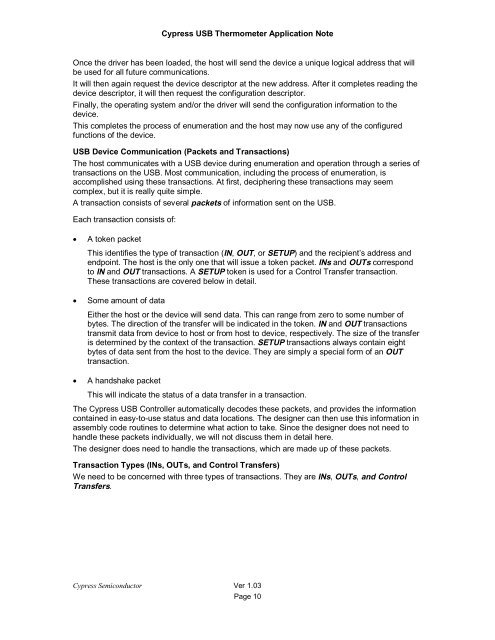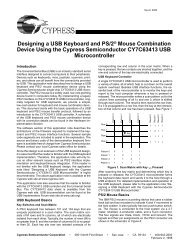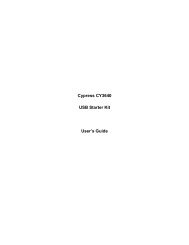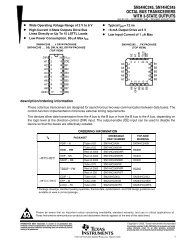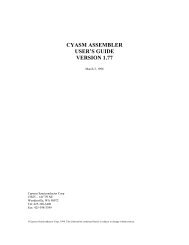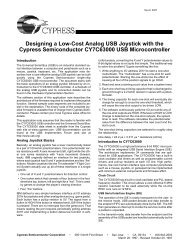Designing a Universal Serial Bus (USB) Device Using the Cypress ...
Designing a Universal Serial Bus (USB) Device Using the Cypress ...
Designing a Universal Serial Bus (USB) Device Using the Cypress ...
You also want an ePaper? Increase the reach of your titles
YUMPU automatically turns print PDFs into web optimized ePapers that Google loves.
<strong>Cypress</strong> <strong>USB</strong> Thermometer Application Note<br />
Once <strong>the</strong> driver has been loaded, <strong>the</strong> host will send <strong>the</strong> device a unique logical address that will<br />
be used for all future communications.<br />
It will <strong>the</strong>n again request <strong>the</strong> device descriptor at <strong>the</strong> new address. After it completes reading <strong>the</strong><br />
device descriptor, it will <strong>the</strong>n request <strong>the</strong> configuration descriptor.<br />
Finally, <strong>the</strong> operating system and/or <strong>the</strong> driver will send <strong>the</strong> configuration information to <strong>the</strong><br />
device.<br />
This completes <strong>the</strong> process of enumeration and <strong>the</strong> host may now use any of <strong>the</strong> configured<br />
functions of <strong>the</strong> device.<br />
<strong>USB</strong> <strong>Device</strong> Communication (Packets and Transactions)<br />
The host communicates with a <strong>USB</strong> device during enumeration and operation through a series of<br />
transactions on <strong>the</strong> <strong>USB</strong>. Most communication, including <strong>the</strong> process of enumeration, is<br />
accomplished using <strong>the</strong>se transactions. At first, deciphering <strong>the</strong>se transactions may seem<br />
complex, but it is really quite simple.<br />
A transaction consists of several packets of information sent on <strong>the</strong> <strong>USB</strong>.<br />
Each transaction consists of:<br />
• A token packet<br />
This identifies <strong>the</strong> type of transaction (IN, OUT, or SETUP) and <strong>the</strong> recipient’s address and<br />
endpoint. The host is <strong>the</strong> only one that will issue a token packet. INs and OUTs correspond<br />
to IN and OUT transactions. A SETUP token is used for a Control Transfer transaction.<br />
These transactions are covered below in detail.<br />
• Some amount of data<br />
Ei<strong>the</strong>r <strong>the</strong> host or <strong>the</strong> device will send data. This can range from zero to some number of<br />
bytes. The direction of <strong>the</strong> transfer will be indicated in <strong>the</strong> token. IN and OUT transactions<br />
transmit data from device to host or from host to device, respectively. The size of <strong>the</strong> transfer<br />
is determined by <strong>the</strong> context of <strong>the</strong> transaction. SETUP transactions always contain eight<br />
bytes of data sent from <strong>the</strong> host to <strong>the</strong> device. They are simply a special form of an OUT<br />
transaction.<br />
• A handshake packet<br />
This will indicate <strong>the</strong> status of a data transfer in a transaction.<br />
The <strong>Cypress</strong> <strong>USB</strong> Controller automatically decodes <strong>the</strong>se packets, and provides <strong>the</strong> information<br />
contained in easy-to-use status and data locations. The designer can <strong>the</strong>n use this information in<br />
assembly code routines to determine what action to take. Since <strong>the</strong> designer does not need to<br />
handle <strong>the</strong>se packets individually, we will not discuss <strong>the</strong>m in detail here.<br />
The designer does need to handle <strong>the</strong> transactions, which are made up of <strong>the</strong>se packets.<br />
Transaction Types (INs, OUTs, and Control Transfers)<br />
We need to be concerned with three types of transactions. They are INs, OUTs, and Control<br />
Transfers.<br />
<strong>Cypress</strong> Semiconductor Ver 1.03<br />
Page 10


